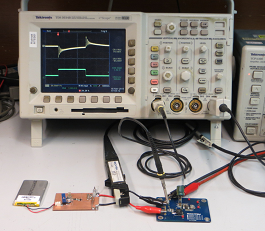
Feature Story
Fast load transient testing
A
quick way to identify stability and other problems in DC/DC converters
using a simple DIY tool
What can you do with a fast load transient tool?
|
 |
|
Load transient testing is a quick way to check power
converter behavior on several aspects: It will show
the converter regulation speed and can highlight loop
stability problems. Other power converter aspects like
load regulation, input voltage stability, slope compensation
issues and layout problems can be quickly spotted as
well. The load transient needs to be very fast to excite
the converter over a very wide frequency band to highlight
all problems. Not all electronic loads can generate
such fast transients, but it is quite easy to build
your own battery powered fast load transient tool from readily
available components.
|
Here are some
examples of converter problems that you can quickly
find with the DIY fast load transient tool:
|
Unstable control
loop
|
If the converter
control loop is not well designed, a fast load step response
will show several bumps or ringing. From the ringing
shape and frequency and some basic formulas, you can
often determine what is wrong with the control loop and make some component adjustments to correct loop bandwidth, poles and zeros..png)
|

|
Unstable Input
supply
|
Ringing on the converter output does not always mean
converter instability. A fast load step on the converter
output will also result in a load step on the converter
input. Unstable input supply or input filter resonance
will sometimes show some ringing on converter output
as well. Input filter resonance can often be damped by adding an electrolytic input capacitor..png)
|
 |
Slope compensation
issues
|
Current mode converters use slope compensation to avoid sub-harmonic oscillation at high duty-cycles. Fast step loads can highlight signs of sub-harmonic switching or other slope compensation related problems. The converter inductor current ripple and slope play an important role here, and wrong inductor values can cause instabilities in high and low duty-cycle applications.
.png) |

|
Layout problems
|
Trace resistance
and trace inductance can impact load regulation and
cause resonance at the load when the load has fast load
steps. It can be improved by using remote sense and
RC snubber damping at load side.
.png) |

|
Building a fast load transient tool yourself
|
The picture
below shows a DIY load transient tool that can generate
very fast load steps. The load step frequency, duty-cycle
and speed can be adjusted, and it is battery powered
so you can apply the load step anywhere in your design
without grounding issues. The application note provides
schematics, BOM, layout and guidelines how to build
this handy tool yourself.
.png) |

|
The application
note
DC/DC converter testing with Fast Load Transients
includes theory and many practical examples on DC/DC
converter trouble shooting using this fast load transient
tool.
|
 |
New simulation
model releases on Richtek Designer: We have
just released 11 new simulation models for industrial
high-current Buck converters, including
RT2856,
RT2857,
RT7298,
RT7299 and
RT7243.Get your power design
started today! |
New Products
|
|
RT5710/11/12/96
series are
2.5V-5.5V input, 0.6V-3.4V output, 1A/1.5A/2A CMCOT™
Synchronous Buck Converters with 1M /1.5MHz fSW
in WDFN-6L 2x2 or TSOT-23-5/6 packages with PG option. CMCOT
topology is ideal for applications with moderate load transients,or
applications that require small minimum ON times.
Find more about ACOT® and
CMCOT™ topologies.
|
|
|
|
|
|
RT9083
is a cost-effective, 30μA Iq, 1.2V-5.5V
input, 0.9V-3.3V fixed output,
250mA LDO voltage regulator with enable function
in TSOT-23-5 package, suitable for portable applications,
ultralow power microcontrollers and notebook computers.
|
|
|
RT6214A/B
(PSM/PWM) is a 4.5V-18V input,
500kHz, 3A output ACOT®
Buck converter in TSOT-23-6 package,
ideal for cost sensitive applications like STBs, and applications
with severe fast load transients, such as core and DDR rails.
|
|
|
RT6268
is a 7V-36V input, 3.7A,
100kHz Asynchronous Buck converter in SOP-8
package. The high 36V input rating and robust current mode
architecture with programmable output current limit makes
it especially suitable for 5V adaptors
and USB chargers
powered from automotive cigarette lighter sockets
|
|
|
RT1741A/B
(adj. /fixed 3.3V Vout) is a high current Buck-Boost
converter designed for input range of 1.8V-5.5V
(battery input) and 1.8V-5.5V output, with 3A max
output load current in WDFN-14AL 4x3. Fixed
2.4MHz fSW or ext sync. from
2.2MHz to 2.6MHz and selectable PSM/PWM mode makes it suitable
for battery powered applications like PDAs, mobile phones
and portable hard disk drives.
|
|